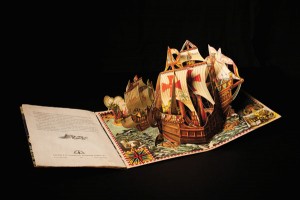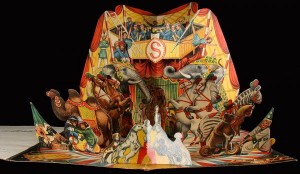Monday’s class saw us engage with the library’s many ancient, illustrated texts. Whilst they were all fascinating, what truly ‘stuck out’ to me was Edward Gorey’s Tunnel Calamity. This was the first time in class that a text’s illustration had delved into three dimensions and sculptural representation. Naturally, Gorey’s ‘accordion’ book reminded me of ‘pop-up books’ that I read as a child where the pictures would jump out at you as you turned the pages.
Similarly, if you are to look up ‘book sculpture’ in Google you will find a beautiful rebellion against two-dimensional representation.
And I wonder how an added dimension of representation influences the embellishment of words? Indeed, how does the ekphrasis of a given three-dimensional piece, which would incorporate depth, differs from two dimensional pieces and illustrations?
Is it inappropriate to treat the book as sculpture?





While some might find it inappropriate to destroy a book to create sculpture, one has to take into account that today it is seen as art. Various artist such as Ann Hamilton and Anselm Kiefer utilize books to create wonderful pieces of art . I believe the idea behind this is that a words can only take a person so far. These wrist defy the function of books and give these sources of information a new function.